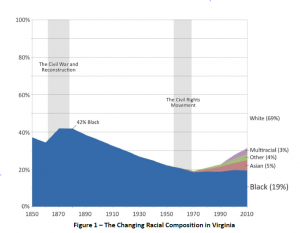Michele P. Claibourn with the Weldon Cooper Demographics & Workforce Group has accomplished something remarkable in her new paper, “Blacks in Virginia: Demographic Trends in Historical Context“: She has brought fresh insights and perspectives to a well-worn topic.
In this chart, Claibourn shows the changing percentage of the African-American population in Virginia. During Reconstruction, the percentage stood at 42%. It declined steadily for decades as African-Americans fled Jim Crow-era oppression and sought better opportunities in northern states. After bottoming out in the 1960s, the African-American population has stabilized. Other minority populations, virtually non-existent before 1970, have surged.
The distribution of African-Americans within Virginia has remain consistent, with the population concentrating in the Tidewater and Piedmont, as seen in Claibourn’s maps below. What I find interesting is that African-Americans west of the Blue Ridge Mountains have gone from a significant minority population to a nearly non-existent one.

Claibourn also calculates a “dissimilarity index” to measure racial segregation. A dissimilarity value of 0 would indicate that the population of a neighborhood contains the same racial proportions as for the political jurisdiction as a whole. The higher the index, the greater the residential segregation. Overall, segregation peaked around 1970, plunged in the 70’s and 80’s and then declined slowly after that. Richmond’s index (52) is slightly less than the average for the 100 largest U.S. metropolitan areas, Hampton Roads (49) is even lower, but the Washington Metro area (62) is somewhat higher.
This map shows how the African-American population in the Washington metro is heavily concentrated in eastern half of the District of Columbia and Maryland counties to the east.
The African-American population in the Richmond region is concentrated in the cities of Richmond and Petersburg and in the outlying, rural counties. The suburbs are predominantly white, as seen at left.
The same pattern — African-American concentrations in older cities and in rural counties — applies to Hampton Roads as well, as seen here.
Claibourn also details the racial gap in education and income. That’s all familiar terrain but it may be worth a look to those interested in the topic.
— JAB






